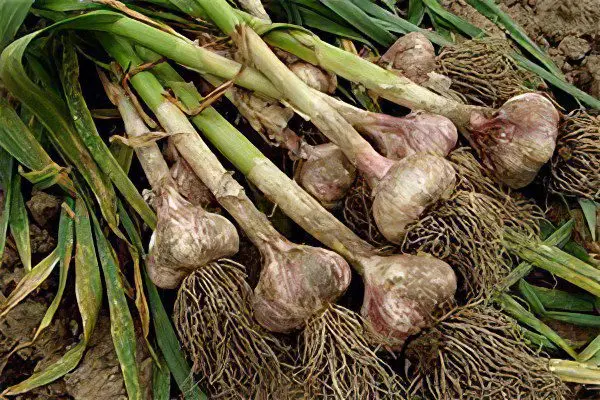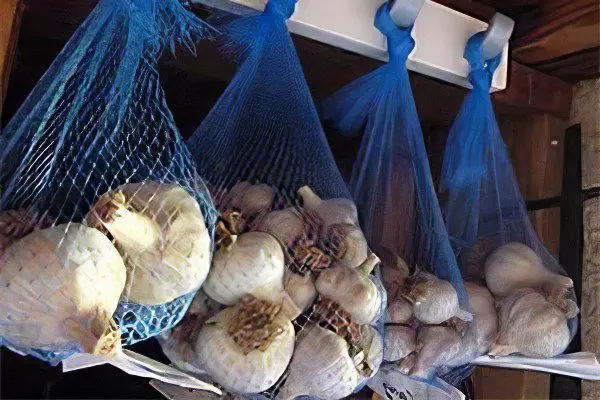Despite the abundance of garlic in the store at any time of the year, it is always a good idea to have a small supply at home. Homeowners are also interested in keeping the garlic harvest as long as possible. Living in your own house, you can use the utility rooms – a basement and a cellar. It is more difficult to store garlic in an apartment, but for such a situation, you can find many ways to store garlic.
Harvesting time for garlic

Before determining the harvesting period for this vegetable, you need to determine the type of garlic.
There are the following types:
Winter shooter, non-shooter;
Spring, or summer, (“spring”).
Differences in appearance – spring garlic has small heads of bright white color with silky scales. Winter garlic is larger, its varieties can have a color range from white to dark purple. Spring garlic tolerates winter storage much better than winter garlic, it can lie unchanged until June.
The time of harvesting or planting, the keeping quality of garlic depends on which species it belongs to. The signal for harvesting spring garlic is yellowing and the beginning of lodging of the leaves. For the middle lane, the harvesting period for summer garlic is the second, third decade of August. Winter garlic begins to be harvested when its lower leaves turn yellow, and the flakes covering the head of garlic become dry. The time of harvesting winter garlic is the third decade of July, the first decade of August.
For harvesting, choose sunny, dry weather.
If you miss the optimal harvesting time, product quality deteriorates noticeably:
The heads of garlic break into individual cloves;
Cracking of the covering scales occurs;
A new cycle of garlic development begins – new roots appear on the bottom, young leaves hatch from the teeth.
Garlic with signs of overgrowing is not suitable for storage. It is advisable to dry it for several days in the open air, or in the shade under a canopy.
What kind of garlic should be stored

Owners of their own garlic beds know that before you start laying garlic for storage, you need to sort it out. Teeth from large heads that do not have signs of disease are left for planting. Seed material is taken from the outer row of teeth, the core of the head is usually not used for propagation.
Do not use for long-term storage:
Garlic heads with mechanical damage;
Overripe crumbling specimens;
Garlic with signs of disease, affected by mold and rot.
Small, non-standard, crumbling heads of garlic are used in the very near future for harvesting for the winter and for cooking. Healthy selected specimens are prepared for bookmarking for long-term storage.
All garlic, both seed and selected for future use, must be dried, the earth removed from the upper covering scales, and the roots cut off. A dry arrow in the center of the head is cut 2-4 cm from the shoulders. If you plan to store garlic tied in a “braid”, the arrow is left longer – at least 30 cm. The garlic purchased in the markets and in the supermarket is most likely already dried and trimmed. It is important to choose healthy specimens for long-term storage, not affected by rot and disease.
Ways to store garlic

There are two main ways to store garlic and its varieties:
Cold method at a temperature of +1 + 3 ° C, humidity 50-70% (suitable for storing spring garlic);
Warm method at a temperature of +18+20°C, humidity 70-80% (ideal for storing winter varieties).
In the conditions of an apartment, it is possible to place garlic on a loggia or balcony part of the time before the onset of stable negative temperatures. In winter, methods of storing this vegetable at room temperature are used.
How to store garlic at home:
In a braided braid. You can weave a garlic braid by analogy with an onion bundle. To do this, when drying, the ends of the stems up to 30 cm long are left, weave a braid out of them, weaving twine or rope into it for strength. It is not recommended to leave such weaving for a long time, as the stems dry out and lose their plasticity. This technique is suitable for spring varieties.
in paraffin wax. So that the garlic does not dry out, you can dip it in melted paraffin or wax before storing it. It will take 150-200 g of paraffin for 50 heads. It is melted in a water bath and dipped in warm head solution. It is impossible to boil the solution, the main thing is to bring the consistency to a liquid state. You can apply wax, paraffin with a brush. After the coating has hardened, the garlic is placed in cardboard boxes.
After treatment with oil and iodine. Boil the vegetable oil, add iodine to it (10 drops per 0,5 l), generously rub the garlic with this mixture. The processed heads are dried in the sun, cleaned in a box, box.
In a refrigerator. The method is suitable for storing a small amount of garlic. It is stored with each head wrapped in cling film to prevent odor.
In oil filling. The cloves are cleaned from the coating, placed in a glass container and poured with boiled and cooled refined sunflower oil. The method is good because garlic-infused oil acquires a pleasant aroma and can be used for dressing salads. At room temperature, the oil can go rancid, it is better to store the container in a cool place, in the refrigerator.
flour. Dried heads of garlic are placed in dry glass jars, sprinkled with flour, corked jars with ordinary lids, and stored at room temperature.
in salt. The method is similar to the previous one, with the difference that salt or dry sawdust is used instead of flour.
In linen bags soaked in saline. If the room humidity is high, salt will protect the garlic from rot and mold. At low air humidity, the canvas is not impregnated with saline, the heads of garlic are sprinkled with onion peel.
To prevent garlic from sprouting, a simple technique is used – its bottom is lightly burned over the flame of a gas burner. Store jars, boxes or boxes with garlic prepared for long-term storage in a dry and cool place, without access to light. Compliance with all conditions will greatly increase the shelf life of garlic.









